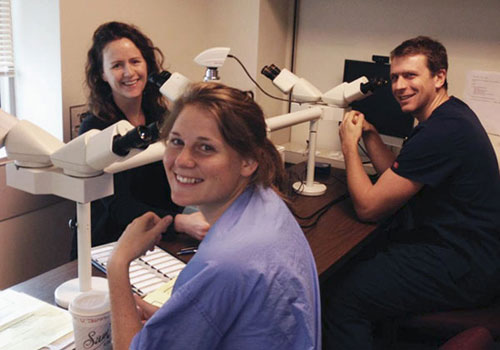Curriculum
Residency training overview

The OHSU Pathology and Laboratory Medicine Residency Program trains skilled diagnosticians, adept at critical thinking, problem solving and collaboration with interdisciplinary teams, in a flexible training environment supported by talented and dedicated teaching faculty. We provide strong anatomic and clinical pathology training enabling trainees to pursue careers in a variety of settings including both private practice and academics.
The aims of the OHSU residency training program in pathology are:
- Train skilled diagnosticians, adept at critical thinking, problem solving and collaboration with interdisciplinary teams
- Provide strong anatomic and clinical pathology training enabling trainees to pursue careers in a variety of settings including both private practice and academics
- Provide a flexible training environment to allow trainees to pursue and develop individual career goals
- Support a healthy work life balance
- Foster a strong sense of professionalism, ethics, sensitivity toward diversity and commitment to patient care
Training in both anatomic (AP) and clinical pathology (CP) is provided in the Pathology Departments at OHSU, the Veterans Administration Medical Center, Kaiser Regional Laboratory, and the Medical Examiner’s Office.
During the residency, the trainee spends a total of 192 weeks in AP and CP. The AP/CP curriculum consists of core rotations designed to provide a fundamental base of knowledge and technical skills and to provide the foundation for the pursuit of advanced fellowship training. Conducting research with emphasis on clinicopathologic correlation and the role of the pathologist as consultant physician is also part of our program. Residents have first call responsibilities for both anatomic and clinical pathology. On average, residents take call one night out of nine. Faculty members are available for backup and for relief on the rare occasion when on-call responsibilities create duty hours issues.
Curriculum, didactics and conferences
The anatomic pathology programs include autopsy, surgical pathology and cytopathology, including fine needle aspiration biopsy and diagnosis. Subspecialty areas include cytopathology, dermatopathology, electron microscopy, forensic pathology, immunohistochemistry, neuropathology, including nerve and muscle biopsies, hematopathology and renal pathology. The clinical pathology training includes laboratory experience in blood banking, chemistry, hematology, toxicology, microbiology, cytogenetics, molecular diagnostics and immunology. An AP & LM didactic curriculum of more than 100 instructional hours covers the breadth of the specialty. This course is given over two years, so that residents experience two cycles prior to board examinations. OHSU Pathology offers a robust conference schedule, with multiple interdisciplinary conferences held daily. Residents are encouraged to attend conferences appropriate to each rotation, and often present
Faculty mentor
Each resident meets regularly with a faculty mentor. The mentor fosters a personal relationship with the trainee and is available to help with professional development and to help clarify career goals and expectations. The mentor also serves as a resource for wellness, ethical and professional issues, and helps the trainee develop his or her annual grand rounds presentation.
Research and scholarly activity
All residents are encouraged to participate in either basic or clinical research projects during their training. We have an annual all-department research event to foster faculty and trainee collaboration and share interests. Elective time may be used to pursue specific research goals.
Read about current research in the Pathology Department at OHSU
All trainees are required to pursue individual scholarly activity and present annually at Pathology Grand Rounds. Trainees are encouraged to submit their work for regional and national conference, and additional financial support is available for trainees who present.
Elective rotations
Electives comprise six rotations out of the four-year residency training program. Electives include advanced training in virtually all service and research laboratories as well as laboratory management and informatics. In addition to the core rotations, elective rotations intended to: augment diagnostic skills in a subspecialty area or extend one's expertise in a core area; gain or extend technical or procedural skills; conduct research; and gain particular laboratory management, test development and technological expertise in one or more areas. The curriculum is flexibly structured to allow as much latitude as possible for the trainee to design a program customized to meet his or her individual needs.
Program strengths
- Balanced AP/CP training with a complement of 12 residents
- Subspecialized surgical pathology rotation
- 22,000 annual cases and consults
- Excellent variety of challenging cases
- Five pathologists' assistants and excellent support staff
- Practical CP rotations with emphasis on boards preparation
- Beautiful new automated core laboratory
- Strong training in blood bank
- Steady autopsy service with well over 50 cases per resident
- VA rotation complements OHSU case mix and is staffed by seven excellent pathologists, including experts in dermatopathology, cytopathology, and neuropathology
- Friendly and flexible work environment
- Quiet campus set in the West Hills, just south of downtown Portland
- Laptop computer, $1200 annual book fund, travel funding
- Fellowship training in hematopathology, cytopathology, neuropathology, molecular pathology, gastrointestinal, pancreaticobiliary, and liver pathology and breast and gynecologic pathology